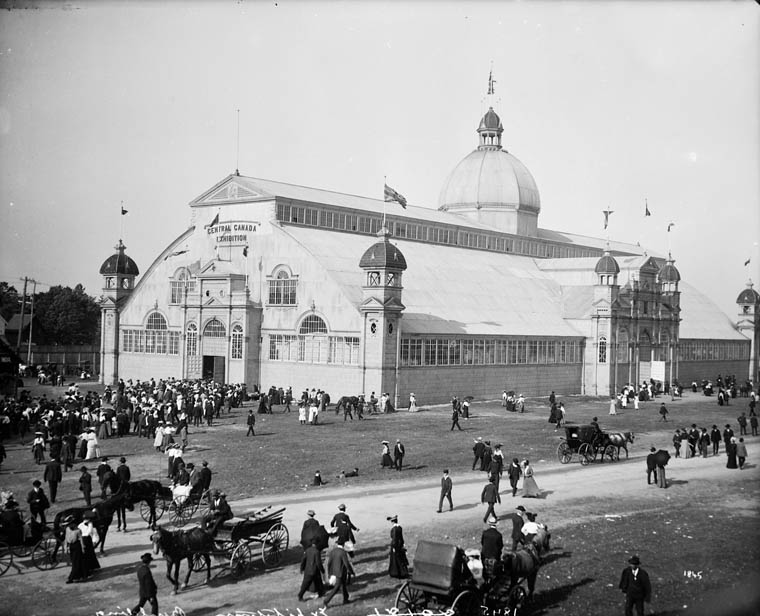We thought we’d take you on a tour of some of the Glebe’s known history! The Glebe itself was established in name more than 170 years ago. However, the Glebe, like the rest of the Ottawa, is built on un-ceded Anishinaabe Algonquin territory. The peoples of the Anishinaabe Algonquin Nation have lived on this territory for millennia and continue to live here today contributing to community and culture. The human history of the area extends at least 8,000 years into the past, well before the establishment of the Glebe in 1837.
The name “glebe’ means “church lands” and the neighbourhood was previously known as “the glebe lands of St. Andrew's Presbyterian Church.” Since then, the Glebe has become a vibrant and bright neighbourhood, with its history still ingrained in the buildings and streets. We’ve taken a look at some of our historical sights and scenes to provide you with a look into the Glebe of days passed!
- Lansdowne Park
- In 1868 the first agricultural fair was held on what was then called the exhibition grounds.
- In 1890 the exhibition grounds were renamed Lansdowne Park. The park was named after the Governor General from 1883 to 1888, the Marquis of Lansdowne.
- In 1967 the Civic Centre opened in Lansdowne Park on Canada Day. This would later be renamed TD Place.
- Aberdeen Pavilion
- Construction began on the Aberdeen Pavilion in 1897 by architect Moses C. Edey. It was officially opened on September 19, 1898, by Governor General Lord Aberdeen. The initial building cost $75,000 to build.
- The Pavilion underwent extensive restoration in 1994 and was completed to its current condition.
- The Pavilion remains standing today. It has very unique architecture, which you can read about on the Heritage Ottawa website.
- The Streetcars
- On June 29, 1891, four tramcars were unveiled in Lansdowne Park. These tramcars were the start of Ottawa’s electric streetcar service, and they ran through the Glebe to the exhibition grounds on Bank Street. The system had the first ever electrically heated cars in Canada, and you could buy three tickets for a mere 10 cents.
- The tramcars lasted until 1959 when the city made the decision to remove them, citing low ridership numbers.
- Old Avalon Theatre
- The Avalon Theatre opened at the corner of Second Ave. and Bank Street on November 16, 1928, in the booming Glebe neighbourhood. The theatre featured cloud and star projection on the ceiling, and a state-of-the-art Simplex projection. P.J. Nolan had previously opened two other theatres in Ottawa, the Rex, and Columbia Theatre; however, this theatre was to be his first to show talking films. An initial equipment setback ironically caused the first 5 months of films to be played without sound, however in March of 1929 the Avalon finally played its first ‘talkie’ film.
- The Avalon closed for retrofit and redesign and reopened as The Glebe Theatre on August 22, 1947.
- The Glebe Theatre showed its final film on October 17, 1956.
- Bank Street Bridge
- Before Lansdowne was the exciting and happening place it is now, people still needed to cross the Rideau Canal to get from the Glebe to Old Ottawa South, and so a bridge needed to be built.
- A wooden bridge was first built over the canal in 1866, but it was replaced just a few years later by a steel swing bridge to allow boats to pass through.
- The swing bridge was replaced with the current bridge in 1912 and was specially designed to be high enough for boats without having to swing open.
- The bridge was restored fully in 1993.
- Old Scotiabank building
- The Bank of Nova Scotia has had a branch on the corner of Bank and Fourth since 1939. The branch was originally in a building at the same location, but the building was later demolished and replaced in the 1960’s by a more modern one in the same spot.
- Photo from the collection of Bruce McCallan
- The Rideau Canal
- The Rideau Canal was completed in 1832 with the military purpose of creating safe passage between Montreal and Kingston. At first the Canal was used for military primarily, however when the Federal government took ownership of it from the British Ordinance in 1868, it quickly began to be used for commercial purposes as well.
- By the early 1900’s the Rideau Canal began to be used for recreational purposes. Those living near the Canal used it for transportation and recreation.
- Wharfs were located on both south and east sides of the canal where paddle-wheel steamers ferried people to and from the exhibition grounds.
- In winter months the Rideau Canal becomes the world’s largest and second longest skating rink. During the Winterlude festival the skating rink is a popular attraction, bringing in thousands of visitors each year.
The Glebe has an endless rich history, and this article contains just a small fraction of the stories and wonders of its past. As the neighbourhood continues to grow and evolve into the future, our history continues to surround the Glebe, touching everyone who passes through it.



